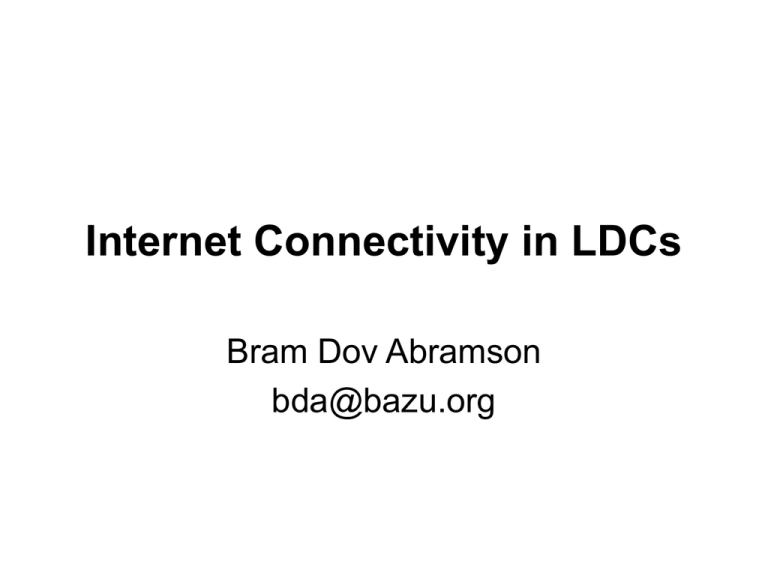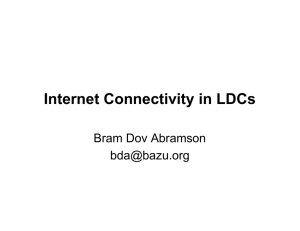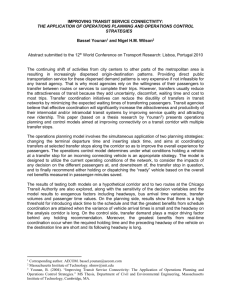Internet Connectivity in LDCs Bram Dov Abramson
advertisement

Internet Connectivity in LDCs
Bram Dov Abramson
bda@bazu.org
I. Connectivity
Definition: what is it?
Measurement: how is it distributed?
Diagnosis: is that a problem?
Analysis: is there a big picture?
II. Transit
Connectivity: Definition
• capacity, connectivity, applications
• Internet connectivity:
– unique ICANN-overseen IP number for duration of
connection;
– ability to exchange general Internet traffic (POP, http)
with other ICANN-overseen IP addresses
• excludes:
– private networks
– closed networks
• implies:
– end-to-end interoperability
Connectivity: Measurement
• building blocks: for each provider,
every international route (City A,
City B, Capacity)
• methodology: network tools,
public data, private data
• automatable: much can be
routinized; some private-sector
firms are building this capability
(Quova, IXIA)
• mid-2001: LDCs had 0.1X percent of Internet users, 0.02 percent of
international Internet bandwidth.
• Africa connected 0.15 percent of international Internet bandwidth,
down from 0.22 percent—but South Africa’s growth was slowest.
• toolkits and international benchmarking: do connectivity market
regulators {need|want} year-on-year results?
• is this a useable metric?
Connectivity: Diagnosis
To diagnose market failure:
• supply must be insufficient to meet demand; and
• market distortions must prevent the additional supply from
being provisioned.
Traditional approaches to demand-supply matching:
• top-down: start with historical bandwidth usage data;
extrapolate future usage; compare to forecasted supply.
But we know little about bandwidth usage.
• bottom-up: start with assumptions about applications usage
and bandwidth used per application; multiply out. But we
know little about applications usage, and nothing about
how available bandwidth affects it.
Connectivity: Diagnosis
Alternative Approaches
• bandwidth per person, but:
– non-users unlikely to produce bandwidth demand, so can’t claim
market failure
• bandwidth per user, but:
– demand for international traffic varies by language, etc.
– some countries produce more non-user (hosting) traffic than others
• bandwidth per host, but:
– does not address international traffic mix
– hosts are hard to count; for LDCs, impossible.
Connectivity: Diagnosis
Bit-Minute Index
BMI Score Distribution
80
70
70
Number of Countries
OECD: 10.79
U.S. & Canada: 6.10
Europe: 6.09
LatAm & Caribbean: 0.87
Asia: 0.79
LDCs: 0.18
Africa: 0.17
60
50
41
40
32
30
20
10
10
0
0.01 - 0.10
0.10 - 1.00
1.00 - 10.00
> 10.00
BMI Score
• calculated as (inbound and outbound international minutes)
/ (international Internet bandwidth)
• assumes international telephone traffic is relevant to
demand for international communications, including users,
hubbing, hosting
• further work needed: international audiovisual traffic?
Connectivity: Analysis
U.S.-centric Internet (1/3)
Largest Interregional Routes, mid-2001
Source: TeleGeography, Inc., Packet Geography 2002
Connectivity: Analysis
Hub-and-Spoke (2/3)
Interregional Internet Capacity, mid-2001
Source: TeleGeography, Inc., Packet Geography 2002
Connectivity: Analysis
Hub-and-Spoke (2/3)
International Internet Providers vs International Internet Capacity, by City
Source: TeleGeography, Inc., Packet Geography 2002
Connectivity: Analysis
Regionalisation (3/3)
• “regionalisation” as new narrative
– in every region except Africa, intraregional growth has
been the fastest-growing set of connectivity routes
• two extremes in intraregional connectivity
– Europe: 75 percent of international Internet bandwidth
– Africa: < 1 percent of international Internet bandwidth
• is higher intraregional connectivity desirable?
– Latin America: 3%, mid-2000; 12%, 2001
– Asia: 7%, mid-1999; 13%, mid-2000; 18%, 2001
I. Connectivity
II. Transit
Definition
Competitive Markets
Developing Markets
Internet Transit: Definition
• buying transit is similar to buying Internet
access, but requires bundling of inter-AS
BGP routing with connectivity
– engaged in only by ISPs with >1 connection to
the Internet
• related to peering
– peering is settlement-free, unlike transit;
– peering allows access only to on-net
destinations, not the whole Internet
Internet Transit:
Competitive Markets
Commodity (n.): tangible good or service resulting
from the process of production. Differences between
commodities, real or imagined, will determine
whether or not they are close substitutes for one
another.
• for purchasers, commodity competition leads to
lower prices
• for vendors, commoditisation is to be staved off:
product differentiation strategies (bundling, features,
etc.) take on greater importance
Internet Transit:
Competitive Markets
Who has the most routes?
Who is the best connected?
Internet Transit:
Developing Markets
Lessons from competitive markets:
• information transparency drives down prices
• price or product unbundling helps build commodity-like
markets
• innovation should be encouraged at each layer
Ways to implement:
• separate pricing for capacity (terrestrial/satellite leased-line
equivalents), connectivity (Internet transit)
• information-gathering and analysis: price-performance
Internet Transit: Developing Markets
Internet Exchange Growth
Source: TeleGeography, Inc., Packet Geography 2002
Internet Transit: Developing Markets
Scattered Pricing for Internet Exchanges
Source: TeleGeography, Inc., Packet Geography 2002
Internet Transit: Developing Markets
Transit Aggregation
• A model exists for discounted transit pricing for research
markets.
– Backbone providers find it advantageous to participate, partly as a
way of developing new markets.
• “ITU Transit POP”: several transit vendors colocate at a
single location and provide very competitive transit pricing
restricted to a well-defined set of providers (“all LDCbased transit ISPs”, etc.).
– subsidise the Transit POP’s maintenance, engineering staff, etc.
– should competitive or subsidised leased-line pricing to get to POP
be provided?
– should several POPs of this type be located in developing regions?
would subsidy be necessary to establish them?
Internet Transit: Developing Markets
Content Peering
Content peering:
• began as non-market innovation (Squid)
• content peering initiative lived briefly; died when
swallowed up by Digital Island (now Cable & Wireless)
• what model could be designed for high cost-of-bandwidth
areas, bundled with measurement tools, standardised, and
made available as an Internet exchange enhancement?
Internet Transit: Developing Markets
Beyond Connectivity
Why did the Internet grow?
• active transmission of authoring and design know-how...
– the Web was once thought of as a two-way medium!
• ... and focus on end-to-end connectivity as efficient twoway distribution plant
What will stimulate bandwidth demand in LDCs?
• active transmission of authoring and design know-how...
– enable LDC citizenries to design their own applications, content
– move beyond point-to-mass paradigm
• ... and focus on end-to-end connectivity as efficient twoway distribution plant
Thanks!
Bram Dov Abramson
bda@bazu.org






